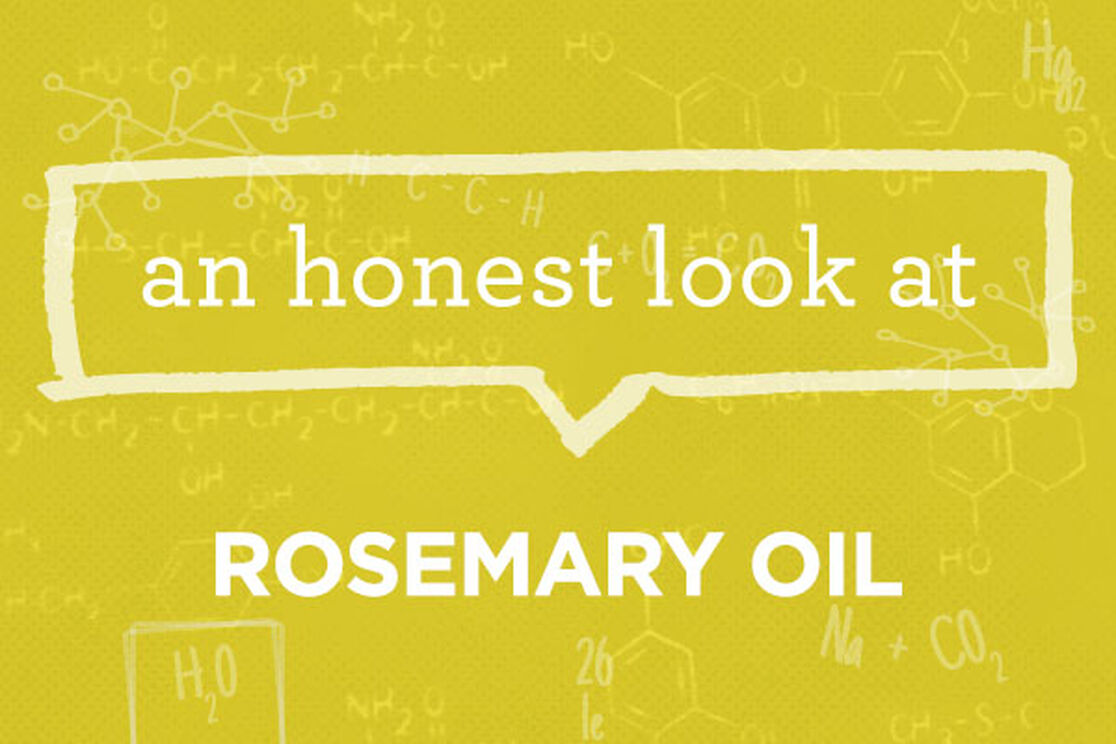This is part of our ongoing series helping consumers better understand chemicals, chemistry, and product formulations. We translate the science, bust the myths, and give you an honest assessment, so you can make informed choices for your family!
Ingredient:
Rosmarinus Officinalis (Rosemary) Oil
What it is:
Rosmarinus Officinalis is an evergreen, bushy shrub with delicate whitish-blue flowers that’s grown all over the world. The oil is obtained through steam distillation of the leaves and flowering tops.
What it does:
Rosemary has been cultivated since ancient times and has been used for a wide variety of purposes. In folklore, it’s associated with love and marriage, as well as birth and death (1). In fact, to this day in England and Germany rosemary is still used in bridal bouquets and a sprig is placed in the cradles of newborns as a measure of protection against evil (1). You’ve likely eaten the herb (and maybe have some in your kitchen right now) as it’s often used in foods and beverages. Rosemary is also used in folk medicine, cosmetics, body care products, fragrances, and much more.
Why we use it:
Rosemary doesn’t just taste good and smell good, it has some other interesting scientifically proven qualities, as well.
- At the right concentration, rosemary helps repel insects, so we included it in our organic Bug Spray (2-4).
- Rosemary oil is also beneficial for skin, so we included it in our Organic Shave Oil (5-8).
Because of its refreshing scent, we also included it in our Wet Mopping Pads and our Citrus Rosemary 4-in-1 Floor Cleaner. We love using ingredients made from plants that take relatively little processing to become a usable raw material. Even more so, we love ingredients with long histories of safe use. Rosemary oil is a multi-tasker that ticks all the Honest boxes!
References:
- CA, R. (1999). Pharmacology of rosemary (Rosmarinus officinalis Linn.) and its therapeutic potentials. Indian journal of experimental biology, 37, 124-131.
- Gillij, Y. G., Gleiser, R. M., & Zygadlo, J. A. (2008). Mosquito repellent activity of essential oils of aromatic plants growing in Argentina. Bioresource technology, 99(7), 2507-2515.
- Regnault-Roger, C., Vincent, C., & Arnason, J. T. (2011). Essential oils in insect control: low-risk products in a high-stakes world.
- Elango, G., Bagavan, A., Kamaraj, C., Zahir, A. A., & Rahuman, A. A. (2009). Oviposition-deterrent, ovicidal, and repellent activities of indigenous plant extracts against Anopheles subpictus Grassi (Diptera: Culicidae).Parasitology research, 105(6), 1567-1576.
- Abu-Al-Basal, M. A. (2010). Healing potential of Rosmarinus officinalis L. on full-thickness excision cutaneous wounds in alloxan-induced-diabetic BALB/c mice. Journal of ethnopharmacology, 131(2), 443-450.
- Altinier, G., Sosa, S., Aquino, R. P., Mencherini, T., Loggia, R. D., & Tubaro, A. (2007). Characterization of topical antiinflammatory compounds in Rosmarinus officinalis L. Journal of agricultural and food chemistry, 55(5), 1718-1723.
- Tabassum, N., & Hamdani, M. (2014). Plants used to treat skin diseases.Pharmacognosy reviews, 8(15), 52.
- Suggs, A., Oyetakin-White, P., & D Baron, E. (2014). Effect of botanicals on inflammation and skin aging: Analyzing the evidence. Inflammation & Allergy-Drug Targets (Formerly Current Drug Targets-Inflammation & Allergy), 13(3), 168-176.
We aim to provide you with the most honest and credible information possible. This article was reviewed for accuracy by The Honest Team and was written based on sources that are linked at the bottom of the article.
blog_review_statement



